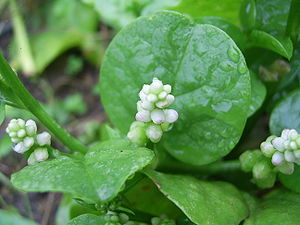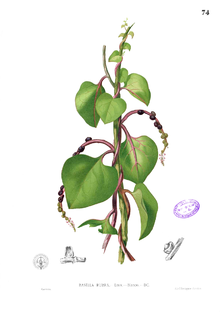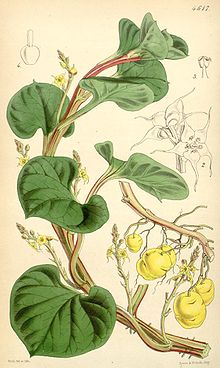Basellaceae
| Basellaceae | ||||||||||||
|---|---|---|---|---|---|---|---|---|---|---|---|---|

|
||||||||||||
| Systematics | ||||||||||||
|
||||||||||||
| Scientific name | ||||||||||||
| Basellaceae | ||||||||||||
| Raf. |
The basellaceae (Basellaceae) are a family in the order of caryophyllales (Caryophyllales) within the flowering plant . Some species have parts of plants that are eaten by humans. Some Anredera and Basella species are used as ornamental plants .
description


Vegetative characteristics
Basellaceae are usually perennial herbaceous plants or rarely subshrubs . They grow upright on their own or often as climbing plants . The roots are fibrous to thickened. Some species form rhizomes or tubers, which can be both underground and above ground, as persistence organs. The basal areas of the shoot axes are often thickened, which makes some species somewhat succulent . The shoot axes of some species can be several meters long. All parts of the plant are mostly hairless.
The stalked or sessile leaves are mostly alternate , rarely almost opposite . The simple leaf blade is often a bit fleshy. The leaf margin is usually smooth, rarely toothed by glands. The stomata are paracytic. Stipules are absent.
Inflorescences and flowers
Many flowers stand together in axillary or terminal, with or without inflorescence shafts, spiked , paniculate or racemose inflorescences with about three durable or early falling bracts . Under each stalked or sessile flower there are two opposite, durable or early falling bracts.
The relatively small, hermaphrodite (rarely functionally unisexual) flowers are radial symmetry , sometimes cleistogamous and usually five-fold. There is a flower cup (hypanthium). The only two opposite, corolla-like, membranous to very thick or rarely fleshy sepals are free or sometimes fused at their base, offset from the bracts by 180 ° and are fused at least with the base of the petals. During the flowering period, the sepals are greenish, whitish to reddish and while the fruit is ripening they are brownish to more or less black. The usually five (rarely four to 13) petals are only fused at their base up to a maximum of two thirds of their length and are similar in shape and color to the sepals. There may be similar, at least not real in parts of Portulakgewächsen, sepals and petals and sepals are perhaps shifted, modified bracts (bracts), while the petals shifted sepals represent and real petals missing (HP Sharma 1961 or CR Sperling 1987).
There is a circle of mostly five (rarely four to nine) stamens . The stamens are only fused with the petals at their base up to a maximum of two thirds of their length. The colpaten or porate pollen grains have a perforate or rarely reticulate or spinulose surface. Three carpels are a single-chamber, Upper permanent ovary grown and have in basal placentation only one amphitrope to campylotrope, bitegmische ovule . There are one to three styluses and always three scars. The nectarium is ring-shaped.
Diaspores and seeds
The bloom cladding sheets are thin-walled and dry or fleshy when the fruit is ripe and partially or completely cover the nut fruits - together they form the diaspore , which is also called "utricle" and can be winged. The spherical, mostly rust-colored seeds have a membranous seed coat , much endosperm and a green, spirally twisted, semicircular or horseshoe-shaped embryo .
Ingredients and chromosome numbers
There are betalines available. If flavonols are present then quercetin . There are calcium oxalate crystals accumulated .
The chromosome numbers are n = 11, 12, 22.
Systematics and distribution
The Basellaceae are distributed worldwide today in the tropics and subtropics . The main area of distribution is in the Neotropic . Other original home areas are in Africa including Madagascar . In Eurasia and Australia , individual species are neophytes . Most species thrive in dry habitats .
By George Bentham and Joseph Dalton Hooker 1862-1883 these genera were classified in the Chenopodiaceae or by Augustin Pyramus de Candolle and Alphonse Louis Pierre Pyramus de Candolle 1823-1873 or by G. Nageshwar and M. Radhakrishnaiah 1993 in the Portulacaceae . The surname Basellaceae was published in accordance with the rules of priority in 1837 by Constantine Samuel Rafinesque-Schmaltz in Flora Telluriana , 3, p. 44; the release of Christian Horace Bénédict Alfred Moquin-Tandon took place only in 1840. The type genus is Basella L. synonyms for Basellaceae Raf. are: Anrederaceae J.Agardh and Ullucaceae Nakai .
Within the order of the Caryophyllales , the Basellaceae, Halophytaceae , Didiereaceae , and Montiaceae are in one clade . This clade is also closely related to the cactus family (Cactaceae), purslane family (Portulacaceae), Anacampserotaceae and Talinaceae . The Basellaceae family is monophyletic to the present day with only four genera and around 19 to 25 species (Roger Eriksson 2007).



Genera and species
The plant family of the Basellaceae is quite small with only four genera and around 19 to 25 species in today's scope (status 2011):
-
Salutation Juss. (Syn .: Beriesa Steud. Nom. Nud., Boussingaultia Kunth , Clarisia Abat , Tandonia Moq. ): The two to ten species arewidespreadin Neotropics from Texas , Florida and the Caribbean Islands to the Galapagos and Argentina , for example:
- Madeira wine ( Anredera cordifolia (Ten.) Steenis ): It is native to South America.
- Basella L. (Syn .: Gandola L. ): Of the four to five species, one occurs in tropical to southern Africa , three in Madagascar and one is pantropical.
-
Tournonia Moq. : It contains only one type:
- Tournonia hookeriana Moq. : They spread from western Colombia to northern Ecuador .
- Ullucus Caldas (Syn .: Melloca Lindl. ): It contains only one species:
swell
- The family of Basellaceae in APWebsite. (Section description, distribution and systematics)
- Roger Eriksson: Neotropical Basellaceae : Online at The Royal Botanic Gardens, Kew . (Section description)
- Michael A. Vincent: Basellaceae. , P. 505 - the same text online as the printed work , In: Flora of North America Editorial Committee (ed.): Flora of North America North of Mexico. Volume 4: Magnoliophyta: Caryophyllidae, part 1 , Oxford University Press, New York and Oxford, 2003. ISBN 0-19-517389-9 (sections description, distribution and use)
- Dequan Lu, Michael G. Gilbert: Basellaceae. , Pp. 445–446 - the same text online as the printed work , In: Wu Zhengyi, Peter H. Raven, Deyuan Hong (eds.): Flora of China. Volume 5: Ulmaceae through Basellaceae , Science Press and Missouri Botanical Garden Press, Beijing and St. Louis, 2003. ISBN 1-930723-27-X (section description)
- Roger Eriksson: A synopsis of Basellaceae. , In: Kew Bulletin , Volume 62, 2007, pp. 297-320. (Section systematics)
- CR Sperling, V. Bittrich: Basellaceae. , In: K. Kubitzki & al. (Ed.): Families and genra of vascular plants , 2, 1993, pp. 143-146.
- S. Carlquist: Wood, stem, and root anatomy of Basellaceae with relations to habit, systematics, and cambial variants. In: Flora , Volume 194, 1, 1999, pp. 1-12.
- Urs Eggli (Hrsg.): Sukkulentenlexikon Volume 2 - Dicotyledons except Aizoaceae, Asclepiadaceae, Cactaceae and Crassulaceae , Eugen Ulmer Verlag, Stuttgart, 2002. ISBN 3-8001-3915-4 .
- Family description of the Basellaceae at DELTA by L. Watson & MJ Dallwitz. (Section description)
Individual evidence
- ^ A b Basellaceae in the Germplasm Resources Information Network (GRIN), USDA , ARS , National Genetic Resources Program. National Germplasm Resources Laboratory, Beltsville, Maryland. Retrieved August 28, 2020.
- ↑ Basellaceae at Tropicos.org. Missouri Botanical Garden, St. Louis, accessed August 28, 2020.
- ↑ a b c d e f g Rafaël Govaerts (Ed.): Basellaceae. In: World Checklist of Selected Plant Families (WCSP) - The Board of Trustees of the Royal Botanic Gardens, Kew . Retrieved February 2, 2015.
- ↑ Profile of Anredera cordifolia
- ↑ Basellaceae at Tropicos.org. In: Catalog of the Vascular Plants of Madagascar . Missouri Botanical Garden, St. Louis
- ^ Arne Rousi & al .: The Fruit of Ullucus (Basellaceae), an Old Enigma. In: Taxon , Volume 37, Issue 1, 1988, pp. 71-75.
Web links
- Profiles of species of the Basell family. ( Memento of March 6, 2005 in the Internet Archive )
- Herbarium material.